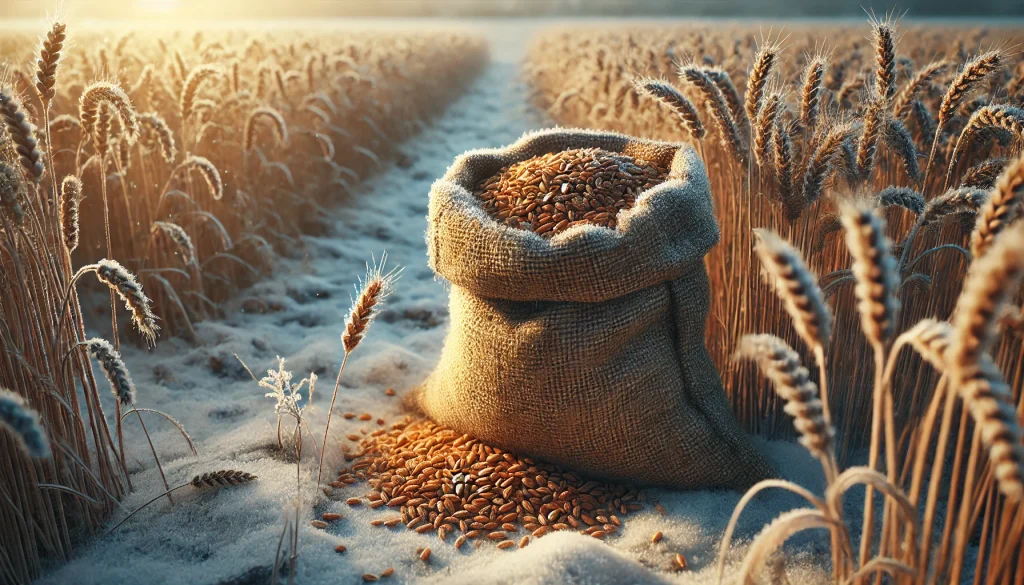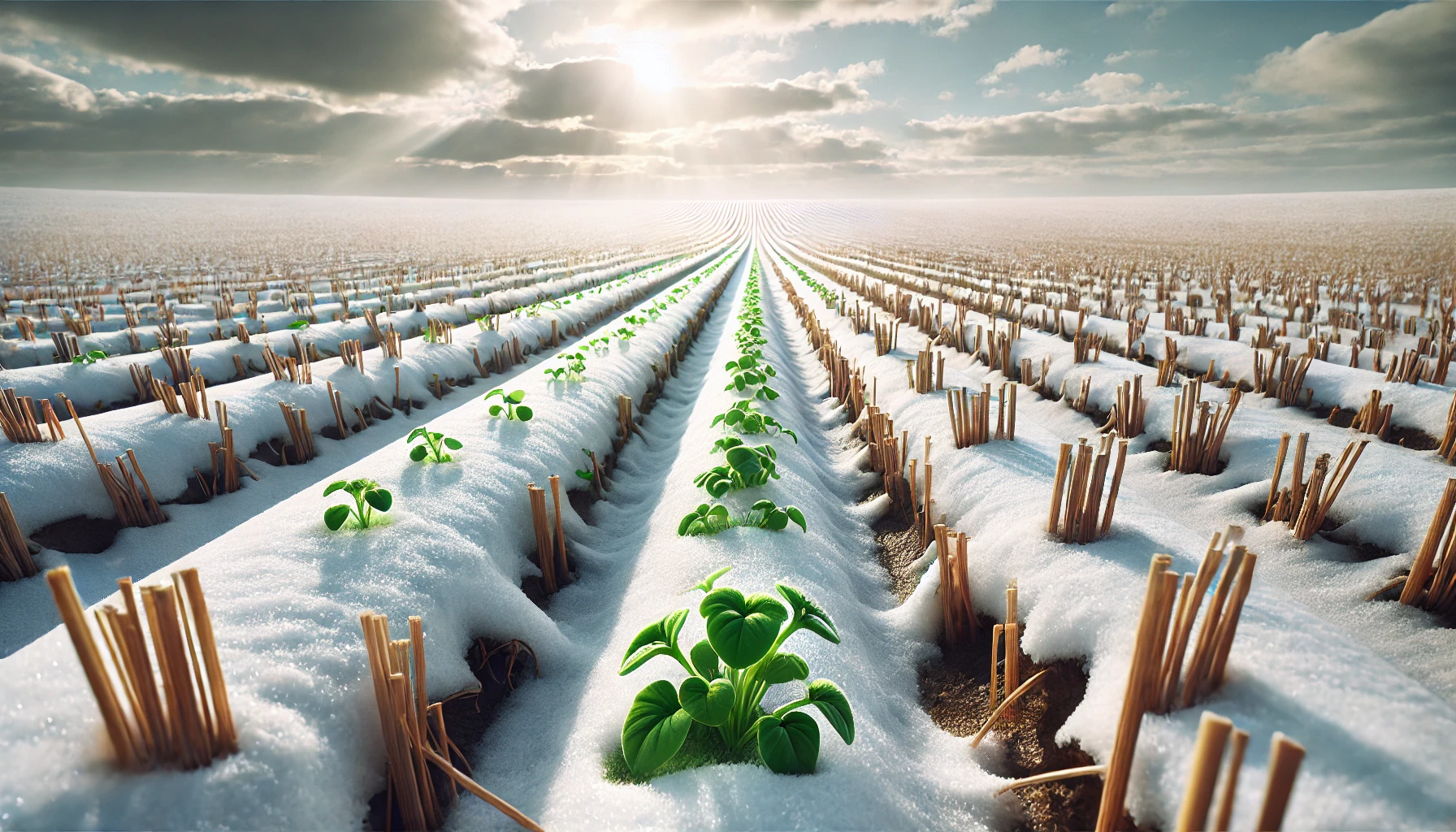In 2024, the total grain harvest amounted to about 56 million tons, and as of September, the volume of winter and spring wheat was 22.3 million tons. The
Winter Wheat: Crop Description

An annual cereal crop that survives the cold season well due to excellent frost resistance. This determines its sowing time – in autumn, at the beginning of September.
Winter wheat is one of the main agricultural crops in Ukraine. It shows high productivity when sowing times and growing technology are followed. It has high soil quality requirements and demands proper moisture balance.
Winter Wheat Varieties
When choosing, it’s important to consider the features and unique characteristics of different varieties of this crop, which allows finding the optimal option considering climatic conditions and specific agricultural activities. The most popular winter wheat varieties in Ukraine are:
- Bohdana. Resistant to major diseases, adaptable to various soil conditions. Known for high yield, at the level of 7.95 t/ha.
- Shestopalivka. Distinguished by high gluten content, resistant to drought and adverse conditions. Estimated yield – 6.25 t/ha.
- Smuglyanka. Not afraid of diseases and pests, which reduces protective treatment costs. Average yield – 9.65 t/ha.
- Antonivka. Resistant to drought, phytodiseases, and negative effects of low temperatures. Distinguished by abundant tillering, with yield potential reaching 11.3 t/ha.
- Podolyanka. A rather undemanding variety, not afraid of drought or grain shattering even when overripe. Good resistance to most diseases. Average yield – up to 7.03 t/ha.
- Kuyalnik. Has shown high resistance to yellow rust and septoria, as well as several other diseases. Mid-early, high-yielding – 8 t/ha.
- Skagen. Has good resistance to stem lodging and grain sprouting in the ear. Vegetation period – about 270 days. Yield – 11.25 t/ha.
- Mudrist Odeska. A variety not afraid of heat and drought, temperature fluctuations, lodging, and shattering. Disease resistant. Average yield – 9.55 t/ha.
When choosing winter wheat varieties, it’s important to consider the climatic zone, location and characteristics of land plots, soil composition, as well as maturation times and yield of the specific crop.
Read also: Soil: What It Is, Types, and Its Fertility
Winter Wheat Growing Technology
To create favorable conditions for the development of this popular agricultural crop, farmers need to know and follow several basic rules. Winter wheat growing technology requires strict adherence to sowing and harvesting times, as well as consideration of numerous details and nuances.
Winter Wheat: Growing Conditions
Shows best yield results on chernozems, sod-podzolic and chestnut soils, as shown on the map. The main winter wheat growing regions in Ukraine are the northern steppe regions, Forest-Steppe, while record yields last year were demonstrated by Odesa, Khmelnytskyi, and Dnipropetrovsk regions. More details on the soil map of Ukraine.
There are also several conditions that need to be considered for the sowing results to meet expectations:
- Temperature. Winter wheat is sown in September when average daily temperatures are +14-17°C. Frost-resistant varieties tolerate frost well and begin to germinate at +1-2°C in the arable layer.
- Sunlight. Determines growth rates. Especially necessary during emergence: prolonged rains and cooling can cause young plants to die. During tillering, sun prevents crop lodging, and during ripening – forms large, high-quality grain.
- Water. Most popular varieties are drought-resistant, but sufficient moisture should still be ensured. In the absence of precipitation after sowing, additional irrigation may be needed – this is especially important in early stages for proper root system formation.
- Soil. Optimal neutral and slightly acidic soils in the range of 5.5-7.5 pH. Humus – from 2%. Salinity negatively affects seedlings, which is important to consider for artificially irrigated fields.
Winter wheat growing regions in Ukraine are quite numerous. And for full growth and development of this crop, not only appropriate conditions but also nutrients are necessary. The basic list includes phosphorus, iron, potassium, copper, zinc, magnesium, nitrogen, calcium. Using organic fertilizers can positively affect yield.
Winter Wheat: Sowing
It’s important to consider recommendations formed for specific varieties, as well as weather, moisture levels, and other factors that affect yield. For winter wheat, growing technology must be adaptive. Farmers need to achieve a balance between basic standards and current conditions.
Winter Wheat Sowing Times
Correct timing determination is key to good yield. Average winter wheat sowing times are presented in the table, but they can be varied.
| Region | Sowing Terms |
| Dnipropetrovsk | September 5-25 |
| Zaporizhzhia | September 5-25 |
| Kirovohrad | September 5-20 |
| Ternopil | September 5-20 |
| Volyn | September 5-20 |
| Vinnytsia | September 5-20 |
| Khmelnytskyi | September 5-20 |
| Odesa | September 10-25 |
| Kherson | September 10-25 |
| Mykolaiv | September 10-25 |
| Kyiv | September 5-15 |
| Chernihiv | September 5-15 |
| Cherkasy | September 5-15 |
| Sumy | August 25 – September 10 |
| Poltava | August 25 – September 10 |
| Kharkiv | August 25 – September 10 |
| Rivne | September 15-25 |
| Lviv | September 10-25 |
Too early winter wheat sowing times lead to premature plant development and possible infection by pathogenic microorganisms, which will spoil a significant part of the harvest due to reduced frost resistance. Late sowing is also dangerous: minimum time remains until cooling, so there’s a risk that the root system won’t have time to fully form. When can winter wheat be sown? Dates should be calculated so that the crop has time to complete these stages:
- emergence;
- root system;
- tillering.
During this time, it should receive the full volume of nutrients, and before transitioning to winter dormancy – have at least 3 shoots. To determine the optimal winter wheat sowing time, one should focus on average daily temperatures, soil moisture, specific variety, and crop rotation – this will help determine when to start work.
Read also: Earth Remote Sensing: Types and Prospects
Soil Preparation for Winter Wheat Sowing
This is one of the key measures requiring careful adherence to technology. The first stage of soil cultivation for winter wheat includes cultivation with mandatory reverse leveling. The second is field disking. It’s important to create a level seedbed to eliminate pests, as well as improve aeration and full plant nutrition. Before sowing, the soil needs to be fertilized with nitrogen, potassium, magnesium, calcium, phosphorus, iron, manganese, and sulfur – the main microelements important for normal crop growth.
For quick and quality task completion, a farmer needs a pre-sowing compactor and a tractor with disk harrows. The online service WEAGRO helps to profitably purchase necessary agricultural equipment by providing installment plans specifically for farmers, allowing equipment purchases from verified manufacturers with deferred payment.
Winter Wheat Predecessors
Proper crop rotation directly affects harvest volumes. Optimal predecessors are black and occupied fallow, as well as:
- legumes;
- potatoes;
- buckwheat;
- flax;
- beets;
- row crops.
Acceptable winter wheat predecessors include soybeans, sunflowers, sorghum, and corn. When choosing, it’s important to consider regional climatic features: in high-moisture areas, all mentioned crops are relevant, but in dry regions (southern part of the country), corn and soybean growing areas won’t be the best choice.
Winter Wheat Seeding Rate
The average rate stays at 150-200 kg/ha. But this is only an approximate guideline, and real figures need to be recalculated annually. Winter wheat seeding rate per hectare in kg should be calculated based on these parameters:
- final density of productive stems;
- tillering coefficient;
- quality of previous treatment;
- soil composition;
- adherence to sowing times;
- size of seed material fractions;
- regional moisture level.
The approximate winter wheat seeding rate can be calculated using the formula:
N=D*M100*G, where:
- D – expected density;
- M – seed material mass;
- G – seed germination.
Example calculation for density of 500 plants per 1 m2, mass of 1000 seeds 50 g, and germination – 96% looks like this:
N=500*50/(100*0.97)=260 kg/ha.
Other parameters can be considered, such as seed material purity and field sowing suitability. Thanks to quality preliminary preparation of land plots and creating a favorable nutrient environment for plants, winter wheat seeding rates can be reduced. And with late sowing, conversely, the volume should be increased.
Winter Wheat Sowing Method
From the very beginning, seed material needs to be prepared: calibrated by size and quality, treated with antibacterial preparations to prevent diseases and pests. Treatment is a safe and ecological way of phytodisease prevention. And this can be done right before sowing. There are quite a few possible seed distribution schemes:
- row (row spacing 15-18 cm/20-22 cm);
- narrow-row (up to 12.5 cm)
- wide-row (from 25 cm);
- cross;
- dotted;
- band;
- strip.
Winter wheat growing technology depends on recommendations relevant for specific varieties. Standard row sowing is universal. Dotted, band, and strip methods can show better results, but this will require appropriate seeders.
Depth – 2-3, but not more than 4 cm. Non-compliance with these recommendations negatively affects tillering, significantly reducing harvest volumes.
Winter Wheat Care
To ensure normal growth and development of winter wheat in spring, it’s important to conduct irrigation – insufficient moisture can negatively affect its yield. Main development phases of winter wheat when additional irrigation is necessary:
- stem elongation period;
- grain formation.
To maintain optimal moisture level, moistening of the top soil layer – up to 50 cm – is needed.
After the winter period, mandatory winter wheat harrowing is conducted to improve crop condition, which can increase yield by 10-20%. This helps improve root system aeration, promoting better water and nutrient penetration to roots, as well as moisture retention. It’s important to consider weather conditions: treatment is more effective on slightly moist soil, but shouldn’t be conducted after heavy rains to avoid damaging soil structure.
Intensive winter wheat growing technology involves using organic fertilizers that will provide the crop with necessary nutrients. This list includes:
- compost;
- manure;
- green manure;
- vermicompost.
This is a source of nitrogen, phosphorus, potassium, and other important elements that promotes soil fertility increase and reduces the need for chemical fertilizers by stimulating biological activity of soil microorganisms. The combination of these procedures allows obtaining quality winter wheat shoots with productive stems.

Winter Wheat Harvesting and Storage
To collect the harvest in full volume, it’s important to start work on time, as soon as the grain reaches maturity. For this, regular visual inspection of land plots is conducted – every two days. When is winter wheat harvested? Everything depends on the current moisture level. We’ve collected the indicators in the table.
| Air Humidity, % | Harvesting | Additional Conditions |
| 85-100 | Only under additional conditions | After 60-90 minutes in sunny weather or 120-180 – without sun |
| 80-85 | Only under additional conditions | After 60 minutes in sunny weather, after 90 – in cloudy weather |
| 75-80 | In warm, dry weather | Without rain, harvesting is allowed, but with mandatory subsequent drying |
| 71-75 | In warm, dry weather | Increase drum speed |
| 65-70 | Allowed | Increase speed |
| 50-65 | Allowed | Set appropriate settings |
| 41-50 | Allowed with appropriate settings | Check losses at all stages, control crushing, reduce speed |
| 26-40 | Gentle settings, significant crushing percentage | Speed reduction, loss checking |
| Below 25 | Under additional conditions | High movement speed and powerful air flows for cleaning |
The optimal moisture level is 51-70%. The main thing is not to miss the harvesting moment, so the crop isn’t spoiled, even if moisture doesn’t match recommended indicators. After harvesting, grain is stored in dry, well-ventilated storage facilities with regulated temperature and humidity indicators.
Conclusion
Winter wheat is one of the most important crops for our country’s agriculture, as it provides both domestic needs and a significant part of exports. Favorable climatic conditions, fertile soils, and many years of growing experience make Ukraine one of the world’s leading wheat producers. The main thing is to correctly calculate when to sow winter wheat and use quality sowing materials. Modern monitoring systems will help farmers simplify all processes and increase yield without using chemicals:
- drones – for problem zone detection;
- precision farming systems – for cost optimization;
- satellite monitoring – for more accurate forecasting.
Read also: Precision Farming in Ukraine: Definition and Prospects
Proper winter wheat growing technology ensures good and stable yield. And for purchasing modern equipment, WEAGRO agricultural installment plan has been developed, making it easy to increase farming efficiency. Quick response without additional documents – and you can order tools and materials with deferred payment.









